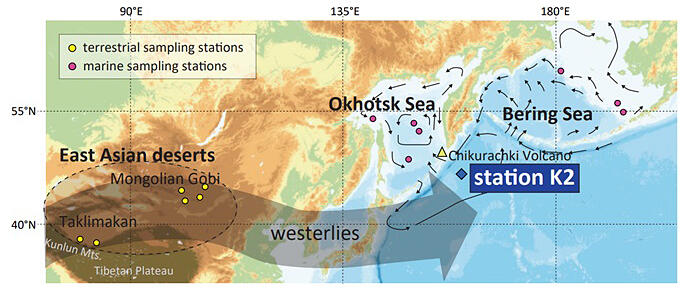Researcher Kana Nagashima and her colleagues of the Earth Surface System Research Center (ESS) at the Research Institute for Global Change (RIGC) at the Japan Agency for Marine-Earth Science and Technology (JAMSTEC), in collaboration with researchers at Hokkaido University, Hiroshima University, and Kyushu University, have developed a new analytical method for estimating the flux of Asian dust deposition into the ocean (deposition amount per unit area and unit time) and its seasonal variation. They also found that approximately 40% of the main supply source of 'iron,' an essential micronutrient for marine phytoplankton, is carried by Asian dust to the ocean surface via the atmosphere. The results were published on September 29 in the journal Scientific Reports.

Provided by JAMSTEC
The research group performed scanning electron microscope-cathodoluminescence (SEM-CL) analysis of single quartz particles (the main mineral component of Asian dust) present in trace amounts in seawater, identifying the quartz supply source from deposited Asian dust and estimating the amount of the dust deposition flux into the ocean. On the basis of Asian dust deposition flux into the ocean, they estimated the quantity of iron dissolved in the surface layer of the subarctic area in the western North Pacific Ocean. From this, the researchers found that in the April to July season, when primary phytoplankton production in the ocean increases, the iron supplied by Asian dust amounts to nearly half that of dissolved iron in the mid-to-surface ocean layers. It was also revealed that Asian dust is the second largest source of dissolved iron following mid-ocean water.
The amount of dissolved iron supplied by anthropogenic aerosols (fine particles such as sulfates and nitrates floating in the atmosphere) was estimated to be approximately half of that supplied by Asian dust, and it was also revealed that the combined iron amounts from the aerosols and Asian dust comprises 40% of the total dissolved iron supply including the dissolved iron supply from the mid-ocean layer. The main supply sources of quartz particles are estimated to be (i) the Taklamakan and Gobi Deserts in East Asia, (ii) the surrounding land areas of the Sea of Okhotsk and the Bering Sea, and (iii) the Kuril and Aleutian Islands with their many volcanoes.
The researchers subsequently performed SEM-CL analysis on tens to hundreds of quartz particles in the desert sand and filtered seawater samples collected from these supply sources. The analytical approach utilizes 'cathodoluminescence,' which is luminescence emitted when a solid material that contains structural defects or impure elements is irradiated with an electron beam, and electron microscopy to investigate the electronic state of the solid material. Therefore, the researchers confirmed that Asian dust is an important iron supply source for living organisms in the ocean, indicating that the dust has positive aspects.
Nagashima stated, "Asian dust blowing toward Japan is frequently on the news this year. Asian dust carried by westerlies from the Taklamakan and Gobi Deserts, which are thousands of kilometers away from Japan, is just like a mirror that projects the environment of East Asia, reflecting the dry earth surface and the strength of the winds. In the future, we will pay attention to whether Asian dust increases or decreases with global environmental changes, and its relationship with the ocean will be more deeply studied."
Journal Information
Publication: Scientific Reports
Title: Asian dust-deposition flux to the subarctic Pacific estimated using single quartz particles
DOI: 10.1038/s41598-023-41201-6
This article has been translated by JST with permission from The Science News Ltd. (https://sci-news.co.jp/). Unauthorized reproduction of the article and photographs is prohibited.




